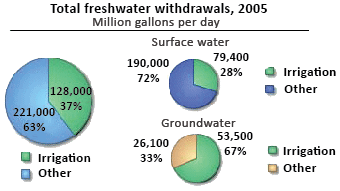Think of what your supper table might be like if water was not used to irrigate crops. Do you think you could survive very long without heaping servings of eggplant, beets, brussels sprouts, and rutabagas? Irrigation water is essential for keeping fruits, vegetables, and grains growing to feed the world’s population, and this has been a constant for thousands of years.
Throughout the world, irrigation (water for agriculture, or growing crops) is probably the most important use of water (except for drinking and washing a smelly dog, perhaps). Almost 60 percent of all the world’s freshwater withdrawals go towards irrigation uses. Large-scale farming could not provide food for the world’s large populations without the irrigation of crop fields by water gotten from rivers, lakes, reservoirs, and wells. Without irrigation, crops could never be grown in the deserts of California, Israel, or my tomato patch.
Irrigation has been around for as long as humans have been cultivating plants. Man’s first invention after he learned how to grow plants from seeds was probably a bucket. Ancient people must have had strong backs from having to haul buckets full of water to pour on their first plants. Pouring water on fields is still a common irrigation method today—but other, more efficient and mechanized methods are also used. One of the more popular mechanized methods is the center-pivot irrigation system, which uses moving spray guns or dripping faucet heads on wheeled tubes that pivot around a central source of water. The fields irrigated by these systems are easily seen from the air as green circles. There are many more irrigation techniques farmers use today, since there is always a need to find more efficient ways to use water for irrigation
When we use water in our home, or when an industry uses water, about 90 percent of the water used is eventually returned to the environment where it replenishes water sources (water goes back into a stream or down into the ground) and can be used for other purposes. But of the water used for irrigation, only about one-half is reusable. The rest is lost by evaporation into the air, evapotranspiration from plants, or is lost in transit, by a leaking pipe, for example.

Read more









